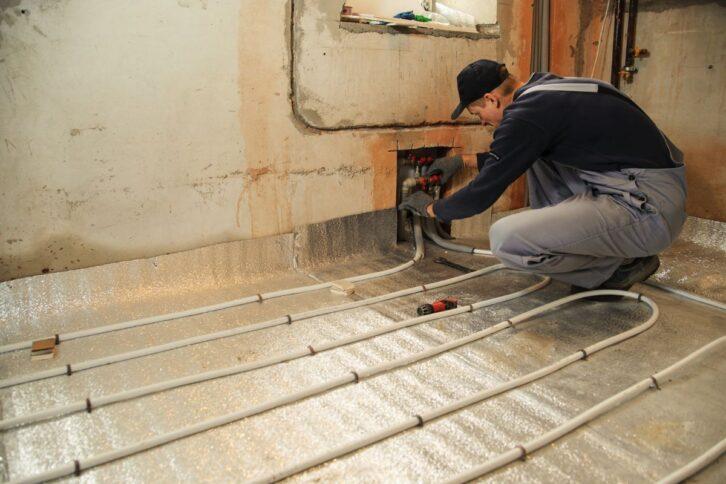Yes, vinyl flooring can be installed over radiant heat systems. Ensure the system is compatible and consult a professional for proper installation techniques. Radiant heat warms vinyl flooring by circulating heated water or electricity through pipes or cables installed beneath the flooring surface.
Radiant heat systems operate by circulating heated water or electricity through pipes or cables installed beneath the flooring surface. Unlike traditional forced-air systems that blow hot air into a room, radiant heat warms objects and surfaces, including the floor, which then radiate heat into the living space. This method results in more consistent warmth throughout the room and fewer hot or cold spots.

Radiant heat systems can be water-based or electric. Water-based systems utilize a network of pipes through which hot water flows from a boiler or other heat source. Electric systems, on the other hand, consist of electric cables or mats installed beneath the flooring. Both types offer their own set of advantages, including energy efficiency, quiet operation, and compatibility with various flooring materials.
One of the key reasons vinyl flooring is suitable for use with radiant heat systems is its ability to conduct heat efficiently. Unlike materials such as carpet, which can act as a barrier to heat transfer, vinyl allows heat to pass through, ensuring maximum comfort underfoot.
Vinyl plank flooring typically comes in various sizes, but the most common dimensions are:
- Length: 48 to 60 inches (121.92 to 152.4 cm)
- Width: 6 to 9 inches (15.24 to 22.86 cm)
- Thickness: 4 to 8 millimeters (0.16 to 0.31 inches)
These dimensions can vary slightly depending on the manufacturer and specific product line. Additionally, there are variations in plank sizes such as narrow planks, wide planks, and extra-long planks, providing homeowners with a range of options to suit their preferences and installation needs.
Vinyl flooring comes in several formats, including planks, tiles, and sheets, each with its installation method and considerations for use with radiant heat. It’s essential to choose a type of vinyl flooring that is specifically designed for use over radiant heat and to follow manufacturer guidelines for installation.
Benefits of Installing Vinyl Flooring Over Radiant Heat
Radiant heat warms the vinyl flooring from below, providing gentle, consistent warmth throughout the room. This creates a cozy environment, particularly during colder months.
Radiant heat systems are known for their energy efficiency, as they require lower temperatures to achieve the same level of comfort as traditional heating methods. When combined with vinyl flooring, which allows heat to transfer more effectively, homeowners can enjoy reduced energy bills and long-term cost savings.
Unlike forced-air systems, which can result in uneven heating and temperature fluctuations, radiant heat systems provide uniform warmth across the entire floor surface. This eliminates cold spots and ensures a comfortable environment throughout the room.
Vinyl flooring is resistant to mold, mildew, and allergens, making it an excellent choice for individuals with allergies or respiratory issues. Radiant heat systems do not rely on air circulation, reducing the spread of dust and other airborne particles.
Installation Process
Installing vinyl flooring over radiant heat systems requires careful attention to detail to ensure a successful and long-lasting result. Here’s a detailed breakdown of the installation process:
Preparation
Begin by preparing the subfloor as per the manufacturer’s guidelines. This typically involves ensuring the surface is clean, dry, and level.
Remove any existing flooring material, adhesive residues, or debris from the subfloor.
Repair any cracks, holes, or uneven areas in the subfloor to create a smooth and stable surface for the vinyl flooring.
Underlayment Installation
Install an appropriate underlayment to provide cushioning, insulation, and moisture protection.
Depending on the specific requirements of the radiant heat system and the type of vinyl flooring being installed, choose an underlayment that is compatible with both.
Roll out the underlayment across the entire surface, ensuring it is free of wrinkles and overlaps. Secure the underlayment in place according to the manufacturer’s instructions.
Flooring Installation
Now it’s time to install the vinyl flooring. The installation method will depend on the type of vinyl flooring chosen (e.g., planks, tiles) and the manufacturer’s recommendations.
For glue-down vinyl flooring, apply the recommended adhesive to the subfloor using a trowel, and carefully lay each plank or tile into place, ensuring proper alignment and spacing.
If using click-lock vinyl flooring, simply interlock the planks or tiles together using the click-lock mechanism, starting from one corner of the room and working your way across.
For loose-lay vinyl flooring, simply lay the planks or tiles directly on top of the underlayment, ensuring a snug fit without any gaps or overlaps.
Finishing Touches
Once the vinyl flooring is installed, trim any excess material along the edges of the room using a utility knife or saw.
Install transitions where the vinyl flooring meets other types of flooring or transitions between rooms to create a seamless transition.
Apply sealant around the perimeter of the room and any seams in the flooring to provide additional protection against moisture and to ensure a watertight seal.
Allow the flooring adhesive (if applicable) to fully cure according to the manufacturer’s instructions before walking on or placing furniture on the newly installed vinyl flooring.
Read More
Can vinyl flooring be installed over existing tile?
What to put under vinyl flooring?
Pros and cons of glued-down vinyl flooring
Pros and cons of click lock vinyl flooring





